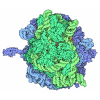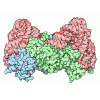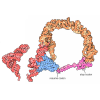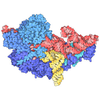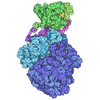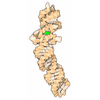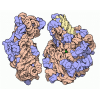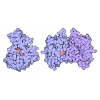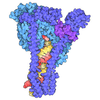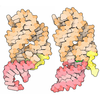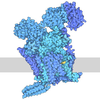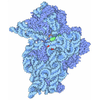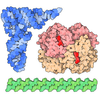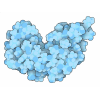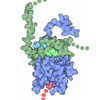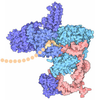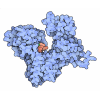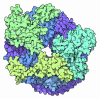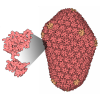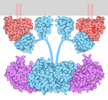[English] 日本語
 Yorodumi
Yorodumi- PDB-9gul: Structure of FLuc-XBP1u+ stalled human 60S ribosome nascent chain... -
+ Open data
Open data
- Basic information
Basic information
| Entry | Database: PDB / ID: 9gul | |||||||||||||||
|---|---|---|---|---|---|---|---|---|---|---|---|---|---|---|---|---|
| Title | Structure of FLuc-XBP1u+ stalled human 60S ribosome nascent chain complex | |||||||||||||||
 Components Components |
| |||||||||||||||
 Keywords Keywords | TRANSLATION / Ribosome-nascent chain / luciferase / folding | |||||||||||||||
| Function / homology |  Function and homology information Function and homology informationtranslation at presynapse / exit from mitosis / eukaryotic 80S initiation complex / negative regulation of protein neddylation / response to insecticide / optic nerve development / regulation of translation involved in cellular response to UV / axial mesoderm development / negative regulation of formation of translation preinitiation complex / regulation of G1 to G0 transition ...translation at presynapse / exit from mitosis / eukaryotic 80S initiation complex / negative regulation of protein neddylation / response to insecticide / optic nerve development / regulation of translation involved in cellular response to UV / axial mesoderm development / negative regulation of formation of translation preinitiation complex / regulation of G1 to G0 transition / ribosomal protein import into nucleus / protein-DNA complex disassembly / positive regulation of intrinsic apoptotic signaling pathway in response to DNA damage by p53 class mediator / 90S preribosome assembly / retinal ganglion cell axon guidance / GAIT complex / positive regulation of DNA damage response, signal transduction by p53 class mediator / TORC2 complex binding / alpha-beta T cell differentiation / G1 to G0 transition / middle ear morphogenesis / cytoplasmic side of rough endoplasmic reticulum membrane / negative regulation of ubiquitin protein ligase activity / homeostatic process / macrophage chemotaxis / lung morphogenesis / male meiosis I / positive regulation of natural killer cell proliferation / Protein hydroxylation / Peptide chain elongation / Selenocysteine synthesis / Formation of a pool of free 40S subunits / Eukaryotic Translation Termination / ubiquitin ligase inhibitor activity / cellular response to actinomycin D / Response of EIF2AK4 (GCN2) to amino acid deficiency / blastocyst development / SRP-dependent cotranslational protein targeting to membrane / negative regulation of ubiquitin-dependent protein catabolic process / positive regulation of signal transduction by p53 class mediator / Viral mRNA Translation / Nonsense Mediated Decay (NMD) independent of the Exon Junction Complex (EJC) / protein localization to nucleus / GTP hydrolysis and joining of the 60S ribosomal subunit / L13a-mediated translational silencing of Ceruloplasmin expression / positive regulation of protein binding / Major pathway of rRNA processing in the nucleolus and cytosol / protein targeting / protein-RNA complex assembly / Nonsense Mediated Decay (NMD) enhanced by the Exon Junction Complex (EJC) / maturation of LSU-rRNA / rough endoplasmic reticulum / Maturation of protein E / Maturation of protein E / MDM2/MDM4 family protein binding / ER Quality Control Compartment (ERQC) / negative regulation of proteasomal ubiquitin-dependent protein catabolic process / Myoclonic epilepsy of Lafora / FLT3 signaling by CBL mutants / Prevention of phagosomal-lysosomal fusion / IRAK2 mediated activation of TAK1 complex / Alpha-protein kinase 1 signaling pathway / Glycogen synthesis / IRAK1 recruits IKK complex / IRAK1 recruits IKK complex upon TLR7/8 or 9 stimulation / Endosomal Sorting Complex Required For Transport (ESCRT) / Membrane binding and targetting of GAG proteins / embryo implantation / Negative regulation of FLT3 / Regulation of TBK1, IKKε (IKBKE)-mediated activation of IRF3, IRF7 / PTK6 Regulates RTKs and Their Effectors AKT1 and DOK1 / Regulation of TBK1, IKKε-mediated activation of IRF3, IRF7 upon TLR3 ligation / Constitutive Signaling by NOTCH1 HD Domain Mutants / IRAK2 mediated activation of TAK1 complex upon TLR7/8 or 9 stimulation / cytosolic ribosome / NOTCH2 Activation and Transmission of Signal to the Nucleus / TICAM1,TRAF6-dependent induction of TAK1 complex / TICAM1-dependent activation of IRF3/IRF7 / APC/C:Cdc20 mediated degradation of Cyclin B / Downregulation of ERBB4 signaling / Regulation of FZD by ubiquitination / cellular response to interleukin-4 / APC-Cdc20 mediated degradation of Nek2A / p75NTR recruits signalling complexes / InlA-mediated entry of Listeria monocytogenes into host cells / TRAF6 mediated IRF7 activation in TLR7/8 or 9 signaling / TRAF6-mediated induction of TAK1 complex within TLR4 complex / Regulation of pyruvate metabolism / NF-kB is activated and signals survival / ossification / Regulation of innate immune responses to cytosolic DNA / Downregulation of ERBB2:ERBB3 signaling / Pexophagy / NRIF signals cell death from the nucleus / VLDLR internalisation and degradation / Regulation of PTEN localization / Activated NOTCH1 Transmits Signal to the Nucleus / Regulation of BACH1 activity / Synthesis of active ubiquitin: roles of E1 and E2 enzymes / MAP3K8 (TPL2)-dependent MAPK1/3 activation Similarity search - Function | |||||||||||||||
| Biological species |  Photinus pyralis (common eastern firefly) Photinus pyralis (common eastern firefly) Homo sapiens (human) Homo sapiens (human) | |||||||||||||||
| Method | ELECTRON MICROSCOPY / single particle reconstruction / cryo EM / Resolution: 2.2 Å | |||||||||||||||
 Authors Authors | Voisin, T.B. / Pellowe, G.A. / Balchin, D. | |||||||||||||||
| Funding support |  United Kingdom, 4items United Kingdom, 4items
| |||||||||||||||
 Citation Citation |  Journal: Nat Struct Mol Biol / Year: 2025 Journal: Nat Struct Mol Biol / Year: 2025Title: The human ribosome modulates multidomain protein biogenesis by delaying cotranslational domain docking. Authors: Grant A Pellowe / Tomas B Voisin / Laura Karpauskaite / Sarah L Maslen / Alžběta Roeselová / J Mark Skehel / Chloe Roustan / Roger George / Andrea Nans / Svend Kjær / Ian A Taylor / David Balchin /  Abstract: Proteins with multiple domains are intrinsically prone to misfold, yet fold efficiently during their synthesis on the ribosome. This is especially important in eukaryotes, where multidomain proteins ...Proteins with multiple domains are intrinsically prone to misfold, yet fold efficiently during their synthesis on the ribosome. This is especially important in eukaryotes, where multidomain proteins predominate. Here we sought to understand how multidomain protein folding is modulated by the eukaryotic ribosome. We used hydrogen-deuterium exchange mass spectrometry and cryo-electron microscopy to characterize the structure and dynamics of partially synthesized intermediates of a model multidomain protein. We find that nascent subdomains fold progressively during synthesis on the human ribosome, templated by interactions across domain interfaces. The conformational ensemble of the nascent chain is tuned by its unstructured C-terminal segments, which keep interfaces between folded domains in dynamic equilibrium until translation termination. This contrasts with the bacterial ribosome, on which domain interfaces form early and remain stable during synthesis. Delayed domain docking may avoid interdomain misfolding to promote the maturation of multidomain proteins in eukaryotes. #1: Journal: Acta Crystallogr D Struct Biol / Year: 2019 Title: Macromolecular structure determination using X-rays, neutrons and electrons: recent developments in Phenix. Authors: Dorothee Liebschner / Pavel V Afonine / Matthew L Baker / Gábor Bunkóczi / Vincent B Chen / Tristan I Croll / Bradley Hintze / Li Wei Hung / Swati Jain / Airlie J McCoy / Nigel W Moriarty ...Authors: Dorothee Liebschner / Pavel V Afonine / Matthew L Baker / Gábor Bunkóczi / Vincent B Chen / Tristan I Croll / Bradley Hintze / Li Wei Hung / Swati Jain / Airlie J McCoy / Nigel W Moriarty / Robert D Oeffner / Billy K Poon / Michael G Prisant / Randy J Read / Jane S Richardson / David C Richardson / Massimo D Sammito / Oleg V Sobolev / Duncan H Stockwell / Thomas C Terwilliger / Alexandre G Urzhumtsev / Lizbeth L Videau / Christopher J Williams / Paul D Adams /    Abstract: Diffraction (X-ray, neutron and electron) and electron cryo-microscopy are powerful methods to determine three-dimensional macromolecular structures, which are required to understand biological ...Diffraction (X-ray, neutron and electron) and electron cryo-microscopy are powerful methods to determine three-dimensional macromolecular structures, which are required to understand biological processes and to develop new therapeutics against diseases. The overall structure-solution workflow is similar for these techniques, but nuances exist because the properties of the reduced experimental data are different. Software tools for structure determination should therefore be tailored for each method. Phenix is a comprehensive software package for macromolecular structure determination that handles data from any of these techniques. Tasks performed with Phenix include data-quality assessment, map improvement, model building, the validation/rebuilding/refinement cycle and deposition. Each tool caters to the type of experimental data. The design of Phenix emphasizes the automation of procedures, where possible, to minimize repetitive and time-consuming manual tasks, while default parameters are chosen to encourage best practice. A graphical user interface provides access to many command-line features of Phenix and streamlines the transition between programs, project tracking and re-running of previous tasks. | |||||||||||||||
| History |
|
- Structure visualization
Structure visualization
| Structure viewer | Molecule:  Molmil Molmil Jmol/JSmol Jmol/JSmol |
|---|
- Downloads & links
Downloads & links
- Download
Download
| PDBx/mmCIF format |  9gul.cif.gz 9gul.cif.gz | 3.4 MB | Display |  PDBx/mmCIF format PDBx/mmCIF format |
|---|---|---|---|---|
| PDB format |  pdb9gul.ent.gz pdb9gul.ent.gz | Display |  PDB format PDB format | |
| PDBx/mmJSON format |  9gul.json.gz 9gul.json.gz | Tree view |  PDBx/mmJSON format PDBx/mmJSON format | |
| Others |  Other downloads Other downloads |
-Validation report
| Summary document |  9gul_validation.pdf.gz 9gul_validation.pdf.gz | 1.7 MB | Display |  wwPDB validaton report wwPDB validaton report |
|---|---|---|---|---|
| Full document |  9gul_full_validation.pdf.gz 9gul_full_validation.pdf.gz | 1.9 MB | Display | |
| Data in XML |  9gul_validation.xml.gz 9gul_validation.xml.gz | 225.9 KB | Display | |
| Data in CIF |  9gul_validation.cif.gz 9gul_validation.cif.gz | 386.2 KB | Display | |
| Arichive directory |  https://data.pdbj.org/pub/pdb/validation_reports/gu/9gul https://data.pdbj.org/pub/pdb/validation_reports/gu/9gul ftp://data.pdbj.org/pub/pdb/validation_reports/gu/9gul ftp://data.pdbj.org/pub/pdb/validation_reports/gu/9gul | HTTPS FTP |
-Related structure data
| Related structure data |  51611MC M: map data used to model this data C: citing same article ( |
|---|---|
| Similar structure data | Similarity search - Function & homology  F&H Search F&H Search |
- Links
Links
- Assembly
Assembly
| Deposited unit | 
|
|---|---|
| 1 |
|
- Components
Components
-Protein , 2 types, 2 molecules 1LI
| #1: Protein | Mass: 30171.441 Da / Num. of mol.: 1 Source method: isolated from a genetically manipulated source Source: (gene. exp.)  Photinus pyralis (common eastern firefly) Photinus pyralis (common eastern firefly)Production host:  Homo sapiens (human) Homo sapiens (human) |
|---|---|
| #14: Protein | Mass: 24570.949 Da / Num. of mol.: 1 / Source method: isolated from a natural source / Source: (natural)  Homo sapiens (human) / References: UniProt: Q96L21 Homo sapiens (human) / References: UniProt: Q96L21 |
-RNA chain , 4 types, 4 molecules 2L5L7L8
| #2: RNA chain | Mass: 894.612 Da / Num. of mol.: 1 / Source method: isolated from a natural source / Source: (natural)  Homo sapiens (human) Homo sapiens (human) |
|---|---|
| #3: RNA chain | Mass: 1641095.500 Da / Num. of mol.: 1 / Source method: isolated from a natural source / Source: (natural)  Homo sapiens (human) Homo sapiens (human) |
| #4: RNA chain | Mass: 38998.078 Da / Num. of mol.: 1 / Source method: isolated from a natural source / Source: (natural)  Homo sapiens (human) / References: GenBank: 23898 Homo sapiens (human) / References: GenBank: 23898 |
| #5: RNA chain | Mass: 50465.812 Da / Num. of mol.: 1 / Source method: isolated from a natural source / Source: (natural)  Homo sapiens (human) Homo sapiens (human) |
+60S ribosomal protein ... , 36 types, 36 molecules LALBLDLGLHLJLLLMLNLOLPLQLRLSLTLULVLWLXLYLZLaLbLcLdLeLfLgLhLi...
-Large ribosomal subunit protein ... , 4 types, 4 molecules LCLELFLm
| #8: Protein | Mass: 47817.641 Da / Num. of mol.: 1 / Source method: isolated from a natural source / Source: (natural)  Homo sapiens (human) / References: UniProt: P36578 Homo sapiens (human) / References: UniProt: P36578 |
|---|---|
| #10: Protein | Mass: 32810.176 Da / Num. of mol.: 1 / Source method: isolated from a natural source / Source: (natural)  Homo sapiens (human) / References: UniProt: Q02878 Homo sapiens (human) / References: UniProt: Q02878 |
| #11: Protein | Mass: 29290.973 Da / Num. of mol.: 1 / Source method: isolated from a natural source / Source: (natural)  Homo sapiens (human) / References: UniProt: P18124 Homo sapiens (human) / References: UniProt: P18124 |
| #43: Protein | Mass: 14771.411 Da / Num. of mol.: 1 / Source method: isolated from a natural source / Source: (natural)  Homo sapiens (human) / References: UniProt: P62987 Homo sapiens (human) / References: UniProt: P62987 |
-Non-polymers , 3 types, 382 molecules 

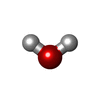


| #47: Chemical | ChemComp-MG / #48: Chemical | ChemComp-ZN / #49: Water | ChemComp-HOH / | |
|---|
-Details
| Has ligand of interest | N |
|---|---|
| Has protein modification | Y |
-Experimental details
-Experiment
| Experiment | Method: ELECTRON MICROSCOPY |
|---|---|
| EM experiment | Aggregation state: PARTICLE / 3D reconstruction method: single particle reconstruction |
- Sample preparation
Sample preparation
| Component | Name: Structure of FLuc-XBP1u+ stalled human 60S ribosome nascent chain complex Type: RIBOSOME / Entity ID: #1-#46 / Source: NATURAL |
|---|---|
| Molecular weight | Experimental value: NO |
| Source (natural) | Organism:  Homo sapiens (human) Homo sapiens (human) |
| Buffer solution | pH: 7.4 |
| Specimen | Embedding applied: NO / Shadowing applied: NO / Staining applied: NO / Vitrification applied: YES |
| Vitrification | Cryogen name: ETHANE |
- Electron microscopy imaging
Electron microscopy imaging
| Experimental equipment |  Model: Titan Krios / Image courtesy: FEI Company |
|---|---|
| Microscopy | Model: TFS KRIOS |
| Electron gun | Electron source:  FIELD EMISSION GUN / Accelerating voltage: 300 kV / Illumination mode: FLOOD BEAM FIELD EMISSION GUN / Accelerating voltage: 300 kV / Illumination mode: FLOOD BEAM |
| Electron lens | Mode: BRIGHT FIELD / Nominal defocus max: 2300 nm / Nominal defocus min: 500 nm |
| Image recording | Electron dose: 40.8 e/Å2 / Film or detector model: FEI FALCON IV (4k x 4k) |
- Processing
Processing
| EM software |
| ||||||||||||||||||||||||
|---|---|---|---|---|---|---|---|---|---|---|---|---|---|---|---|---|---|---|---|---|---|---|---|---|---|
| CTF correction | Type: NONE | ||||||||||||||||||||||||
| 3D reconstruction | Resolution: 2.2 Å / Resolution method: FSC 0.143 CUT-OFF / Num. of particles: 788554 / Symmetry type: POINT |
 Movie
Movie Controller
Controller


 PDBj
PDBj